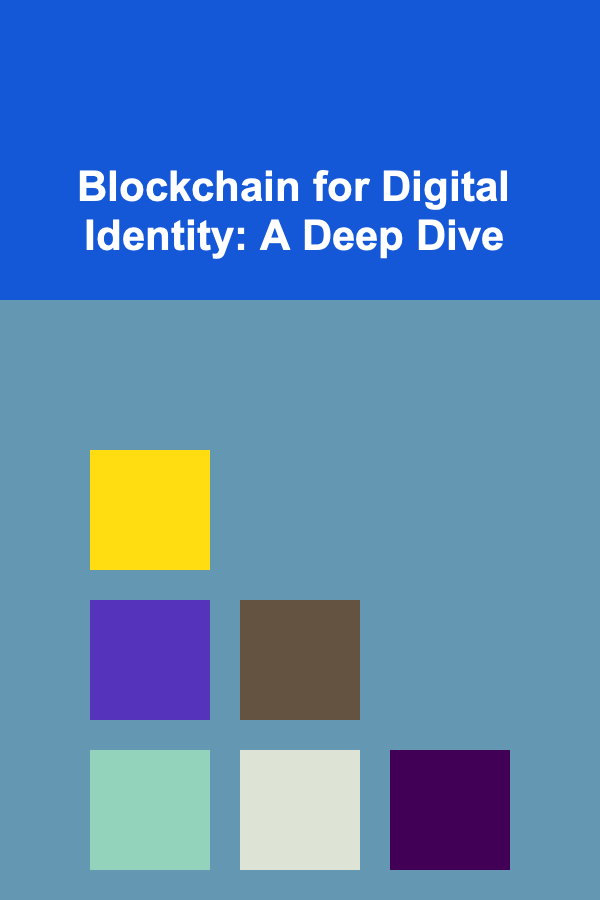
Blockchain for Digital Identity: A Deep Dive
ebook include PDF & Audio bundle (Micro Guide)
$12.99$11.99
Limited Time Offer! Order within the next:

In the increasingly interconnected digital world, the need for robust and secure digital identity solutions is paramount. Traditional methods of identity verification, relying on centralized databases and credential providers, are often vulnerable to data breaches, fraud, and identity theft. Blockchain technology, with its inherent security, transparency, and decentralization, offers a compelling alternative for managing and verifying digital identities. This article explores the potential of blockchain for digital identity, examining its benefits, challenges, use cases, and future outlook.
The Problem with Traditional Digital Identity
Current digital identity systems face several critical challenges:
- Centralized Vulnerability: Centralized databases storing personal information are attractive targets for hackers. A single breach can expose the data of millions of users, leading to identity theft and financial losses.
- Lack of Control: Individuals have limited control over their personal data. Organizations often collect and store excessive information, often without explicit consent or transparency.
- Identity Silos: Identity information is fragmented across various organizations and platforms, leading to inefficiencies and inconsistencies. Users are forced to create and manage multiple accounts and passwords.
- Privacy Concerns: The collection, storage, and use of personal data by centralized entities raise significant privacy concerns. Users may not be aware of how their data is being used or shared.
- Trust Issues: Users must trust centralized authorities to securely manage and protect their personal information. This trust is often misplaced, as evidenced by frequent data breaches and privacy violations.
- Single Point of Failure: If a central authority's system fails, users may be unable to access their accounts or services. This can lead to significant disruptions and inconvenience.
- Costly Infrastructure: Maintaining and securing centralized identity systems requires significant investment in infrastructure, security measures, and personnel.
These limitations highlight the urgent need for a more secure, user-centric, and transparent approach to digital identity management. Blockchain technology provides a promising solution to address these challenges.
How Blockchain Can Revolutionize Digital Identity
Blockchain's inherent characteristics make it well-suited for managing digital identities:
- Decentralization: Blockchain eliminates the single point of failure and reduces the risk of data breaches by distributing identity information across a network of nodes.
- Immutability: Once identity information is recorded on the blockchain, it cannot be altered or deleted, ensuring data integrity and preventing fraud.
- Transparency: All transactions and data changes are recorded on the blockchain and are publicly auditable, promoting transparency and accountability.
- Security: Cryptographic techniques, such as hashing and digital signatures, secure identity information and prevent unauthorized access.
- User Control: Individuals can control their own identity data and grant access to specific information to trusted parties, enhancing privacy and autonomy.
- Interoperability: Blockchain can enable seamless sharing and verification of identity information across different platforms and organizations, reducing identity silos.
- Cost Efficiency: By automating identity verification processes and reducing the need for intermediaries, blockchain can lower the costs associated with identity management.
Blockchain-based digital identity solutions leverage these characteristics to create a more secure, efficient, and user-centric identity ecosystem.
Key Concepts in Blockchain-Based Digital Identity
Understanding these key concepts is crucial for grasping how blockchain can be used for digital identity:
- Self-Sovereign Identity (SSI): SSI empowers individuals to control their own identity data without relying on centralized authorities. Users create and manage their digital identities and selectively share information with trusted parties.
- Decentralized Identifiers (DIDs): DIDs are unique identifiers that are controlled by the identity owner and are not tied to any central authority. They are used to locate and retrieve identity information stored on the blockchain or other decentralized storage systems.
- Verifiable Credentials (VCs): VCs are digitally signed attestations issued by trusted parties that verify specific claims about an individual, such as their age, education, or professional qualifications. They can be presented to other parties to prove their identity or qualifications without revealing unnecessary personal information.
- Wallets: Digital wallets are used to store and manage DIDs, VCs, and other identity-related information. They provide a secure and user-friendly interface for interacting with blockchain-based identity systems.
- Smart Contracts: Smart contracts are self-executing agreements written in code that automate identity verification processes and enforce access control policies. They can be used to verify claims, grant permissions, and manage identity attributes.
- Zero-Knowledge Proofs (ZKPs): ZKPs allow individuals to prove that they possess certain information without revealing the information itself. This is particularly useful for preserving privacy while still verifying identity claims.
These concepts form the building blocks of blockchain-based digital identity solutions and enable a more secure and user-centric identity ecosystem.
Use Cases for Blockchain Digital Identity
The potential applications of blockchain digital identity are vast and span across various industries:
- Government Services: Securely issuing and managing national IDs, driver's licenses, and other government credentials. Streamlining access to government services and reducing fraud.
- Healthcare: Verifying patient identities, managing medical records, and ensuring data privacy and security. Enabling patients to control access to their medical information.
- Financial Services: Streamlining KYC/AML compliance, preventing fraud, and enabling secure and efficient transactions. Facilitating cross-border payments and identity verification.
- Education: Verifying academic credentials, managing student records, and preventing diploma mills. Enabling students to control their educational data.
- Supply Chain: Tracking and tracing products, verifying supplier identities, and ensuring product authenticity. Reducing counterfeit goods and improving supply chain transparency.
- Online Voting: Securely verifying voter identities and preventing voter fraud. Increasing trust and transparency in the electoral process.
- Access Control: Granting access to buildings, networks, and other resources based on verified identities. Reducing the risk of unauthorized access.
- Social Media: Verifying user identities and preventing fake accounts. Combating online harassment and misinformation.
- Travel and Tourism: Streamlining border control, verifying passport information, and enabling secure and efficient travel.
- E-commerce: Verifying buyer and seller identities and preventing fraud. Enabling secure online transactions.
These use cases demonstrate the broad applicability of blockchain digital identity across various sectors.
Benefits of Blockchain Digital Identity
Implementing blockchain-based digital identity solutions offers numerous benefits:
- Enhanced Security: Blockchain's inherent security features, such as decentralization and immutability, protect against data breaches and identity theft.
- Improved Privacy: Individuals have greater control over their personal data and can selectively share information with trusted parties.
- Increased Efficiency: Automating identity verification processes and reducing the need for intermediaries streamlines operations and lowers costs.
- Reduced Fraud: Blockchain's transparency and immutability make it difficult to commit identity fraud.
- Enhanced Trust: Blockchain provides a secure and transparent platform for verifying identities, increasing trust among parties.
- Greater Interoperability: Blockchain enables seamless sharing and verification of identity information across different platforms and organizations.
- User Empowerment: Individuals have greater control over their digital identities and can participate in the digital economy with confidence.
- Lower Costs: Reduction in reliance on centralized, often proprietary, systems leads to overall cost savings for both businesses and individuals.
- Improved Compliance: Easier adherence to regulations such as GDPR and CCPA, as users have better control and visibility over their data.
These benefits make blockchain digital identity a compelling alternative to traditional methods.
Challenges and Considerations
Despite its potential, implementing blockchain digital identity faces several challenges:
- Scalability: Blockchain networks can be slow and expensive, especially for large-scale identity management. Scalability solutions, such as layer-2 protocols and sidechains, are needed to address this challenge.
- Interoperability: Different blockchain platforms may not be compatible with each other, hindering the seamless sharing and verification of identity information. Standards and protocols are needed to promote interoperability.
- Regulatory Uncertainty: The regulatory landscape for blockchain and digital identity is still evolving, creating uncertainty for businesses and organizations. Clear and consistent regulations are needed to foster innovation and adoption.
- User Adoption: Many people are unfamiliar with blockchain technology and may be hesitant to adopt blockchain-based identity solutions. User-friendly interfaces and educational initiatives are needed to promote adoption.
- Data Privacy: While blockchain enhances privacy, it is important to carefully consider the implications of storing personal information on a public ledger. Privacy-enhancing technologies, such as zero-knowledge proofs, can help mitigate these concerns.
- Key Management: Securely managing private keys is crucial for protecting digital identities. Lost or stolen keys can lead to identity theft. Robust key management solutions are needed to protect against this risk.
- Governance: Establishing clear governance structures and decision-making processes is essential for ensuring the long-term sustainability and integrity of blockchain-based identity systems.
- Legacy System Integration: Integrating blockchain-based identity solutions with existing legacy systems can be complex and challenging. Careful planning and implementation are required.
- Quantum Computing Threat: The future development of quantum computers poses a threat to the cryptographic algorithms used to secure blockchain networks. Research and development are needed to develop quantum-resistant cryptographic techniques.
Addressing these challenges is crucial for realizing the full potential of blockchain digital identity.
Technical Architectures and Implementations
Several technical architectures are being explored for implementing blockchain-based digital identity:
- Public Blockchains: Public blockchains, such as Ethereum and Bitcoin, offer high levels of security and transparency but may be less scalable and more expensive.
- Private Blockchains: Private blockchains offer greater scalability and control but may be less transparent and secure.
- Consortium Blockchains: Consortium blockchains are governed by a group of organizations, offering a balance between security, transparency, and control.
- Hybrid Blockchains: Hybrid blockchains combine the features of public and private blockchains, offering a flexible and customizable solution.
Different implementations are also being developed, including:
- Sovrin: An open-source, decentralized identity network built on a permissioned distributed ledger. Focuses on self-sovereign identity.
- uPort: A self-sovereign identity platform built on the Ethereum blockchain.
- Civic: An identity verification platform that uses blockchain to securely store and share identity information.
- Microsoft ION: A decentralized identity system built on the Bitcoin blockchain using layer-2 technology (Sidetree).
The choice of architecture and implementation depends on the specific requirements and constraints of the use case.
The Future of Blockchain Digital Identity
The future of blockchain digital identity is promising. As the technology matures and adoption increases, we can expect to see:
- Wider Adoption: Blockchain digital identity will become more widely adopted across various industries and use cases.
- Standardization: Industry standards and protocols will emerge to promote interoperability and compatibility.
- Regulatory Clarity: Clear and consistent regulations will be established to govern blockchain and digital identity.
- Improved User Experience: User-friendly interfaces and educational initiatives will make blockchain digital identity more accessible to the general public.
- Integration with AI and IoT: Blockchain digital identity will be integrated with artificial intelligence (AI) and the Internet of Things (IoT) to create new and innovative applications.
- Increased Focus on Privacy: Privacy-enhancing technologies, such as zero-knowledge proofs, will be more widely used to protect personal information.
- Decentralized Autonomous Organizations (DAOs) for Identity Management: DAOs may emerge as a means to govern and manage digital identity systems in a decentralized and transparent manner.
Blockchain digital identity has the potential to transform the way we manage and verify identities in the digital age, creating a more secure, efficient, and user-centric identity ecosystem.
Conclusion
Blockchain technology offers a compelling solution to the challenges facing traditional digital identity systems. By leveraging its inherent security, transparency, and decentralization, blockchain can empower individuals to control their own identity data, reduce fraud, and streamline identity verification processes. While challenges remain, the potential benefits of blockchain digital identity are significant. As the technology matures and adoption increases, we can expect to see a fundamental shift in the way we manage and interact with digital identities, creating a more secure, efficient, and user-centric digital world.
Reading More From Our Other Websites
- [Personal Financial Planning 101] How to Make a Financial Plan as a Couple
- [Home Space Saving 101] How to Store Seasonal Items Without Cluttering Your Home
- [Organization Tip 101] DIY Home Maintenance Checklist: Easy Tips for Homeowners
- [Home Security 101] How to Build a Neighborhood Watch Program
- [Home Family Activity 101] How to Have a Family Dance-Off and Get Active Together
- [Organization Tip 101] How to Use Labels for Different Sections in Your Library
- [Personal Investment 101] How to Turn Deep Learning into a Sustainable Source of Passive Income
- [Toy Making Tip 101] Best Step‑by‑Step Blueprint for Crafting Hand‑Painted Ceramic Toy Animals
- [Personal Care Tips 101] How to Conceal Fine Lines and Wrinkles with Skincare Products
- [Personal Care Tips 101] Best Post‑Workout Personal Care: Recovery & Muscle Repair

How to Set Up a Personal Library Lending System
Read More
How to Use Blockchain in Healthcare for Data Management
Read More
How to Find TV Shows That Are Visually Stunning
Read More
How To Discover Novels That Have a Devoted Following
Read More
How to Track Bills When You Have Multiple Accounts
Read More10 Tips for Organizing Your Paper Bills with a Tracker
Read MoreOther Products

How to Set Up a Personal Library Lending System
Read More
How to Use Blockchain in Healthcare for Data Management
Read More
How to Find TV Shows That Are Visually Stunning
Read More
How To Discover Novels That Have a Devoted Following
Read More